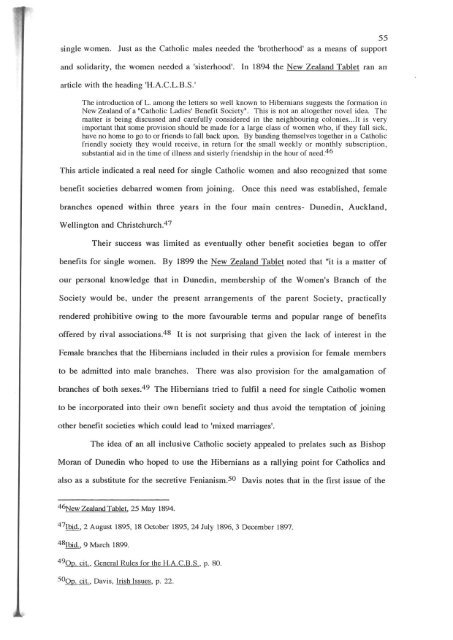TRANSPLANTED IRISH INSTITUTIONS - University of Canterbury
TRANSPLANTED IRISH INSTITUTIONS - University of Canterbury
TRANSPLANTED IRISH INSTITUTIONS - University of Canterbury
Create successful ePaper yourself
Turn your PDF publications into a flip-book with our unique Google optimized e-Paper software.
55<br />
single women. Just as the Catholic males needed the 'brotherhood' as a means <strong>of</strong> support<br />
and solidarity, the women needed a 'sisterhood'. In 1894 the New Zealand Tablet ran an<br />
article with the heading 'H.A.C.L.B.S.'<br />
The introduction <strong>of</strong> L. among the letters so well known to Hibernians suggests the formation in<br />
New Zealand <strong>of</strong> a "Catholic Ladies' Benefit Society". This is not an altogether novel idea. The<br />
matter is being discussed and carefully considered in the neighbouring colonies .. .!t is very<br />
important that some provision should be made for a large class <strong>of</strong> women who, if they fall sick,<br />
have no home to go to or friends to fall back upon. By banding themselves together in a Catholic<br />
friendly society they would receive, in return for the small weekly or monthly subscription,<br />
substantial aid in the time <strong>of</strong> illness and sisterly friendship in the hour <strong>of</strong> need. 46<br />
This article indicated a real need for single Catholic women and also recognized that some<br />
benefit societies debarred women from joining. Once this need was established, female<br />
branches opened within three years in the four main centres- Dunedin, Auckland,<br />
Wellington and Christchurch. 47<br />
Their success was limited as eventually other benefit societies began to <strong>of</strong>fer<br />
benefits for single women. By 1899 the New Zealand Tablet noted that "it is a matter <strong>of</strong><br />
our personal knowledge that in Dunedin, membership <strong>of</strong> the Women's Branch <strong>of</strong> the<br />
Society would be, under the present arrangements <strong>of</strong> the parent Society, practically<br />
rendered prohibitive owing to the more favourable terms and popular range <strong>of</strong> benefits<br />
<strong>of</strong>fered by rival associations. 48 It is not surprising that given the lack <strong>of</strong> interest in the<br />
Female branches that the Hibernians included in their rules a provision for female members<br />
to be admitted into male branches. There was also provision for the amalgamation <strong>of</strong><br />
branches <strong>of</strong> both sexes. 49 The Hibernians tried to fulfil a need for single Catholic women<br />
to be incorporated into their own benefit society and thus avoid the temptation <strong>of</strong> joining<br />
other benefit societies which could lead to 'mixed marriages'.<br />
The idea <strong>of</strong> an all inclusive Catholic society appealed to prelates such as Bishop<br />
Moran <strong>of</strong> Dunedin who hoped to use the Hibernians as a rallying point for Catholics and<br />
also as a substitute for the secretive Fenianism. 50 Davis notes that in the first issue <strong>of</strong> the<br />
46New Zealand Tablet, 25 May 1894.<br />
471bid.,2 August 1895, 18 October l895, 24 July 1896,3 December 1897.<br />
48Ibid, 9 March 1899.<br />
490p. cit., General Rules for the H.A.C.8.S., p. 80.<br />
500p. cit., Davis, Irish Issues, p. 22.
















